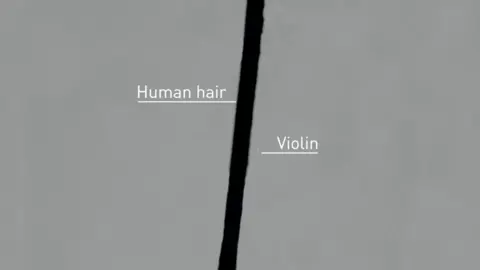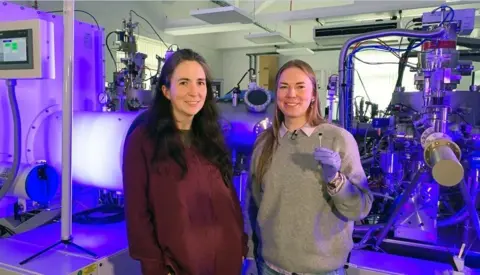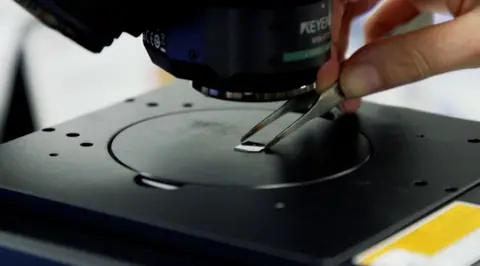Scientists create 'world's smallest violin'
 Loughborough University
Loughborough UniversityIf you have a complaint over your timetables or exams, Loughborough University may not be the place to air it.
For physicists at the university believe they have created the world's smallest violin using nanotechnology.
They say work on the tiny instrument, which is smaller than the width of a human hair, will help with research into an array of applications from improving the efficiency of computers to finding new ways of harvesting energy.
Prof Kelly Morrison, head of the university's physics department, said: "A lot of what we've learned in the process has actually laid the groundwork for the research we're now undertaking."
 Loughborough University
Loughborough UniversityThe violin measures 35 microns long and 13 microns wide, with a micron being one millionth of a metre. A human hair typically ranges from 17 to 180 microns in diameter, for comparison.
It was created to test the capabilities of the university's new nanolithography system, which allows researchers to build and study tiny structures.
"Our nanolithography system allows us to design experiments that probe materials in different ways – using light, magnetism, or electricity – and observe their responses," Prof Morrison said.
"Once we understand how materials behave, we can start applying that knowledge to develop new technologies, whether it's improving computing efficiency or finding new ways to harvest energy.
"But first, we need to understand the fundamental science and this system enables us to do just that."
 Loughborough University
Loughborough UniversityThe phrase "can you hear the world's smallest violin playing just for you?" is thought to have first appeared on an episode of TV show M*A*S*H in 1978, and usually mocks overly dramatic complaints.
The violin is a microscopic image rather than a playable instrument and has not been officially confirmed as the world's smallest violin, the university said.
To create it, Prof Morrison was joined by Dr Naëmi Leo and research technician Dr Arthur Coveney.
A small chip was coated with two layers of gel-like material called a resist, before it was placed under the NanoFrazor, a nano-sculpting machine.
The machine uses thermal scanning probe lithography, a technique where a heated, needle-like tip "writes" highly precise patterns at the nanoscale.
This allowed the violin design to be etched on to the chip's surface layer.
 Loughborough University
Loughborough UniversityAfter it was etched, the underlayer of the resist was dissolved to leave behind a violin-shaped hole.
The university said a thin layer of platinum was then deposited into the chip before a final rinse in acetone removed any remaining material to leave the finished violin.
It takes around three hours to create a violin using the nanolithography system, but the research team's final version took several months as they refined and tested different techniques.
"I'm really excited about the level of control and possibilities we have with the set-up," Prof Morrison added.
Follow BBC Leicester on Facebook, on X, or on Instagram. Send your story ideas to [email protected] or via WhatsApp on 0808 100 2210.
